Archive:Rail accident fatalities in the EU
- Data from January 2015. Most recent data: Further Eurostat information, Main tables and Database. Planned article update: (dd) Month YYYY(, hh:00).
In 2013, 1982 significant railway accidents were registered in the 28 EU countries, killing a total of 1130 persons and seriously injuring a further 912. Fatalities in the EU as a whole fell from 1 517 in 2007 to 1 109 in 2013 (-27%). Railway suicides are reported separately. With 2819 reported cases in 2013, they greatly outnumber the victims of accidents counted in railway safety statistics.
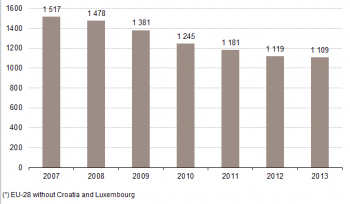
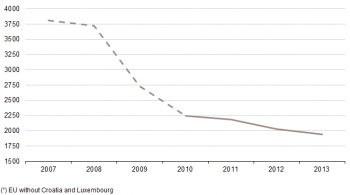
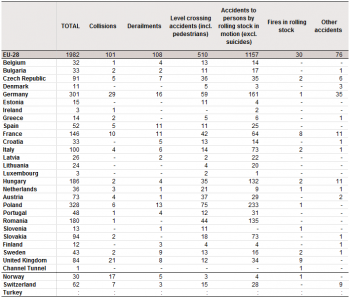
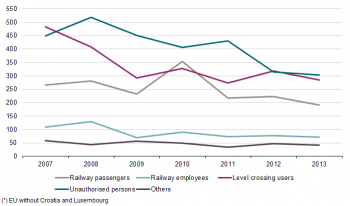
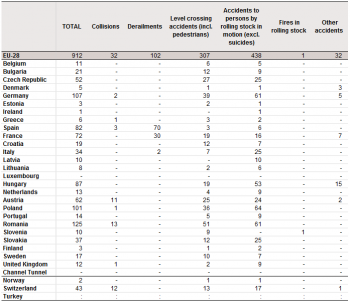
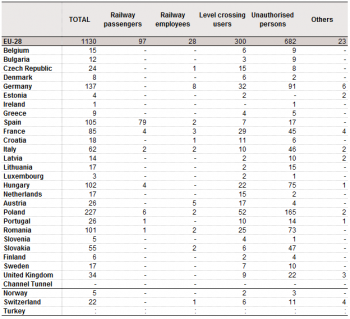
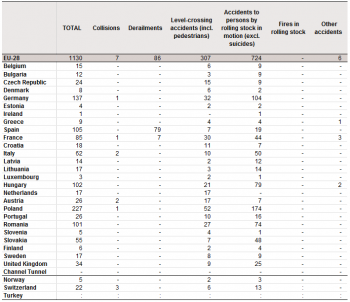
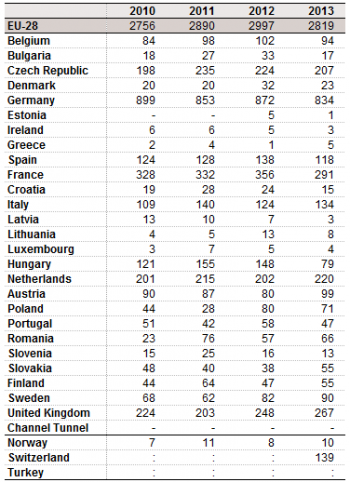
Main statistical findings
The European Railway Agency has been collecting railway safety data based on the Common Safety Indicators (CSIs) since 2006. EU countries have been applying the same standard definitions since 2010, so data are now fully standardised.
Accidents in 2013 - 4% fewer than in 2012
Rail accidents fell between 2007 and 2013 (see Figure 2). In the EU as a whole, numbers were nearly halved (falling from 3811 to 1946). Accidents declined by nearly 4% between 2012 and 2013, though not in all categories: collisions, derailments and fires in rolling stock increased somewhat. Accident figures are only reliable as of 2010, when common definitions were adopted. Belgium, Poland and Slovakia typically reported all accidents in the past, not just "significant" ones. Consequently, figures for several accident types have been lower since 2010.
The detailed 2013 figures show that the biggest single accident category in the EU as a whole is accidents to persons caused by rolling stock in motion, representing 58% of all accidents. Typically, these accidents involve trespassers hit by trains on railway tracks. The other major category is accidents at level crossings, including pedestrians, totalling 510 (26%). These two categories account for 84% of all significant accidents.
Poland, Germany and Hungary registered most accidents in absolute terms (see Table 1). In 2013,
- 17% of all accidents (328) recorded in the 28 EU countries occurred in Poland
- 15% (301 ) in Germany
- and 9% (186) in Hungary.
In both Ireland and Luxembourg, 3 accidents occurred in 2013. The Channel Tunnel is listed separately. A single accident was reported: a fire in rolling stock, with no injuries or deaths.
Serious injuries: a clear decline since 2008, especially among level crossing users
Between 2007 and 2013 the average annual decrease in the number of seriously injured persons fell by 6.9% annually for the EU as a whole. The annual decrease was even steeper for level crossing users (-8.5%). The number of seriously injured railway passengers declined less, at 5.4% a year, peaking in 2010 (owing to the major train collision in Buizingen, south of Brussels), was lower, at 5.4% per year. The fall would have been even greater had it not been for 2013's most serious single train accident, the derailment of a high-speed train in Santiago de Compostela (Spain).
In 2013, the pattern for the various accident categories was reflected in the number of people injured (see Table 2). Most (438, 48% of the total) were seriously injured in accidents involving rolling stock in motion, while level crossing accidents injured 307 persons, 34% of the total.
The other types of accidents led to far fewer injuries. 32 people were seriously injured in train collisions in 2013 (2012: 120), most in just 2 countries: Romania and Austria. Comparisons between countries may be slightly biased, given the different reporting standards applied before 2010.
Rail accident deaths: most involve trespassers
Figure 1 shows absolute numbers of persons killed in railway accidents. Total fatalities gradually declined from 1517 in 2007 to 1109 in 2013, a 27% fall. Rail passengers account for a small share: just 3% in 2011 and 2012. The proportion was nearly 9% in 2013 (97 deaths), owing to the aforementioned disaster in Santiago de Compostela, where 79 people died (all of Spain’s “Railway passengers” deaths and 81% of rail passenger deaths in the 28 EU countries – see Table 3). Without this single accident, rail passengers would have accounted for just 1.7% of total rail fatalities.
The European Railway Agency estimates the fatality risk for rail passengers over the last three years at 0.13 deaths per 1 000 million passenger kilometres – close to the risk for air passengers and lower than that for bus/coach passengers in Europe (see http://www.era.europa.eu/Document-Register/Documents/SPR2014.pdf).
Among the 28 EU countries, unauthorised persons and level crossing users accounted for 87% of all rail accident fatalities.
The Santiago de Compostela accident also represents a very large share of fatalities in the "derailments" category (Table 4), which shows fatalities broken down by accident type in 2013. There were no reported deaths from “fires in rolling stock”. As expected, most deaths resulted from accidents to persons by rolling stock in motion (724 deaths, 64% of the total) and level crossing accidents (307 deaths, 27% of the total).
Far more railway suicides than deaths&serious injuries resulting from railway accidents
Suicides on railway premises rose between 2010 and 2012 to just under 3 000 , with a slight decrease in 2013. The number of suicides on rail premises is significant in all EU countries. germany accounted for nearly 30% of the 2013 total (834).
Data sources and availability
The figures supplied here are selected from data reported to the European Railway Agency (http://era.europa.eu) with which Eurostat has an agreement on disseminating data through Eurobase.
Railway accident data are also collected through Annex H to the Regulation providing for statistical returns on railway traffic and transport (Regulation (EC) 91/2003). However, this data collection is to be phased out, as similar data are available through the ERA. Similar data can thus be found elsewhere in the Eurobase data tree, in the 'Railway transport' sub-domain under 'Railway transport - Accidents (rail_ac)'. The Agency's data are located in the horizontal multi-modal information (tran) under 'Transport safety (tran_sf)'.
Comparing these data might occasionally reveal differences as the ERA handles its own compilation procedures and quality checks. Also, whereas data are reported to the ERA by the national safety authorities, data reported to Eurostat in the framework of Regulation 91/2003 are reported by the National Statistical Offices. The latter might depend on data from the same national authorities, but not necessarily so.
Context
Over the years national rail networks have developed different technical specifications for infrastructure. Different gauge widths, electrification standards and safety and signalling systems all make it more difficult and more costly to run a train from one country to another. Specific EU legislation exists to promote interoperability and overcome such differences. The creation of an integrated European railway area hence calls for improved “interoperability” – or technical compatibility - of infrastructure, rolling stock, signalling and other subsystems of the rail system, as well as less complex procedures for the authorisation of use of rolling stock across the European Union's rail network.
The European Railway Agency plays a central role in promoting interoperability and harmonising technical standards, a process in which cooperation between EU Member States and rail stakeholders is essential.
The European Railway Agency (ERA) based in Lille/Valenciennes, France, helps to build an integrated European railway area by reinforcing rail safety and promoting interoperability. Set up in 2006, ERA develops common technical specifications and common approaches to safety, working closely with stakeholders from the rail sector as well as with national authorities, the EU institutions and other interested parties. Featuring a dedicated Safety Unit, ERA also monitors and reports on rail safety in the EU.
Railway safety data have been collected by the ERA since 2006 within the so-called Common Safety Indicators (CSIs), introduced by Annex I of the Railway Safety Directive (Directive 2004/49/EC). Member States have a legal obligation to submit their CSI data to the ERA. The Agency publishes an Overview of safety-related CSIs as soon as data are consolidated. The CSIs data are reported via, and available through ERAIL system. The full set of CSI data is made available in the annually published Railway Safety Performance Report. Note that accident figures are reliable from 2010 onwards, as per the strict application of common definitions. Belgium, Poland and Slovakia typically reported all railway accidents in the past, instead of significant accidents only. This led to a lower count in several categories of accidents since 2010.
See also
Further Eurostat information
Database
- Transport, see:
- Multimodal data (tran)
- Transport safety (tran_sf)
- Rail transport safety (tran_sf_rail)
- Rail accidents by type of accident (ERA data) (tran_sf_railac)
- Rail accidents victims by type of accident (ERA data) (tran_sf_railvi)
- Rail accidents involving the transport of dangerous goods (ERA data) (tran_sf_raildg)
- Suicides involving railways (ERA data) (tran_sf_railsu)
- Rail transport safety (tran_sf_rail)
- Transport safety (tran_sf)
Data collected through Annex H of Regulation (EC) 91/2003:
- Transport, see:
- Railway transport (rail)
- Railway transport – Accidents (rail_ac)
- Annual number of victims by type of accident (rail_ac_catvict)
- Annual number of accidents by type of accident (rail_ac_catnmbr)
- Annual number of accidents involving the transport of dangerous goods (rail_ac_dnggood)
- Railway transport – Accidents (rail_ac)
Publications
Methodology / Metadata
Composition of EU aggregates
EU-28: European Union composed of 28 Member States: Belgium (BE), Bulgaria (BG), Czech Republic (CZ), Denmark (DK), Germany (DE), Estonia (EE), Ireland (IE), Greece (EL), Spain (ES), France (FR), Croatia (HR), Italy (IT), Cyprus (CY), Latvia (LV), Lithuania (LT), Luxembourg (LU), Hungary (HU), Malta (MT), the Netherlands (NL), Austria (AT), Poland (PL), Portugal (PT), Romania (RO), Slovenia (SI), Slovakia (SK), Finland (FI), Sweden (SE) and the United Kingdom (UK).
Please note that Cyprus, Malta and Iceland do not feature any railways. Liechtenstein's railways are operated by ÖBB and included in the Austrian data.
The tables in this publication include the Channel Tunnel as separate entity. Data referring to the Channel Tunnel cannot be attributed to either France or the United Kingdom. Channel Tunnel figures are always included in the EU aggregates.